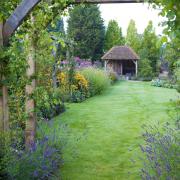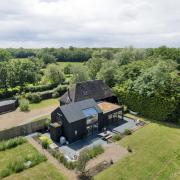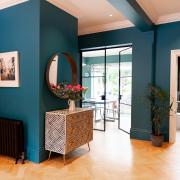Margo Selby’s love of textiles began at six when her grandmother taught her how to crochet. From there her passion only grew, leading her to take a BA degree in woven textiles at the Chelsea College of Art and Design and study it for a further two years during her Masters. However, it was after university that Margo would meet some of the greatest influences in her artistic creations and approach to business.
‘After graduating I had a fellowship at The Ann Sutton Foundation,’ Margo shares. ‘Ann was incredibly inspiring in her treatments of woven textiles as a fine art form which is something I focus on today. Throughout my career, I’ve been fortunate to collaborate with some amazing creative and commercial partners, like Osborne & Little and Alternative Flooring. These partnerships have pushed me creatively but also provided invaluable insights into the aspects of running a business and working with textile manufacturers and suppliers. I’m always receptive to learning from others.’

‘I’m constantly juggling the balance of art and commercial design, letting both aspects have their own identity, but working in harmony. I’ve grown my art practice organically and am now fortunate to be represented by Cynthia Corbett Gallery. Again, finding supportive partners and mentors has been key to growing both as an artist and business owner.’

‘Even today it’s a constant challenge balancing all the different elements of the business,’ Margo admits. ‘However, where I used to feel guilty about spending a week sitting at the loom, I’ve realised now, that it’s essential. It’s here when I’m making with my hands that quality design work comes, which adds so much value to the business.’

The weaving studio is open to visitors Monday to Friday between 10am and 4pm and the team is more than happy to show guests the looms in action or offer insight into any current art or weaving projects they’re working on. Though presently Margo is also dedicating her days to her artist’s residency with Standfast and Barracks in Lancaster as part of the Art in Manufacturing for The National Festival of Making and British Textile Biennial. ‘It’s been a great opportunity to take my art practice in a new direction, pushing the boundaries of what I’ve produced to date, and while it’s a big investment of my time, it’s wonderful to be so immersed in a project of this scale. It will, I’m sure, only add to our ethos of Art into Industry,’ she explains.

At the start of the year, Margo created a large-scale, site-specific installation for Collect 2024 at Somerset House in London. The 16-metre-long piece was Margo’s largest handwoven artwork to date and is a celebration of the mathematical and technical possibilities of weaving and the crossovers of pattern, tone and rhythm found in both music and interlacing textiles. For Margo, it was one of the most enjoyable projects she’s worked on. ‘It was amazing to see my handwoven textiles on a much grander scale and to work with composer Helen Craddock who created an original music score for strings to accompany the work,’ she explained.
Despite being only partway through the year, the last few months have been incredibly hectic, with Margo also having just launched a collection with design house and high-street retail icon Habitat, to mark their 60th anniversary. ‘It’s brilliant to see my work on their shelves, opening my designs to a much wider audience,’ she says. ‘Habitat was one of the first brands I collaborated with when I began my design practice, and it was a pleasure to delve into their archives as part of the project.
‘For this capsule collection, I chose to focus on the graphic, primary aesthetic from the brand’s signature designs from the 70s and 80s. This resonated with my ongoing fascination with typography and its potential in pattern design. The colour application is bold and references iconic colours from Habitat’s history, such as the Yves Klein blue.’

No stranger to accolades for her amazing designs, Margo was also the winner of the Eureka Design Awards in 2008. ‘In terms of helping put the business on the map, winning the Eureka Design Awards was somewhat of a pivotal point in my career,’ Margo says. ‘It elevated my profile and opened many doors within the design industry. It was during this project which connected designers with manufacturers and retailers where I first designed my range of homewares for Habitat and ultimately contributed towards me connecting with them again, years later, to be a part of their special birthday.’ And yet even with all that Margo already has going on, when asked about her plans for the coming months, there was no sign of slowing down. It would indeed seem the loom never sleeps, but Margo admits it takes a team effort to keep the golden thread spinning.

‘As I mentioned rugs have become a major part of the business, and my husband Peter, who’s worked with rug shops in India for many years, is a constant touchstone. They’re all part of the fibre that keeps the loom turning and able to continue weaving the magic.’ margoselby.com





























